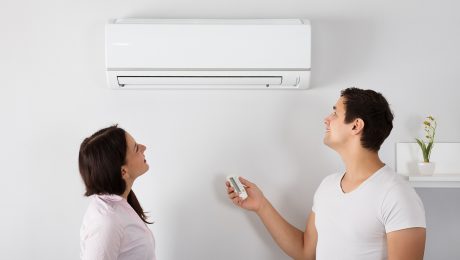Even the best air conditioners require service from time to time. If they don’t receive it, they’ll struggle to function, resulting in energy efficiency and durability issues.
The question is: just how often should I service my air conditioner? Yearly? Every 6 months? Every 2 years? We’ll reveal the answer and much more below!

Air Conditioner Maintenance Tips:
Changing the HVAC Filter
Air conditioners and furnaces take in all sorts of dust and dirt that naturally floats in the air. As such, to reduce the amount of residue they take in, they equipped with HVAC filters. These filters stop residue in tracks but the filters get absolutely inundated with it in the process.
For this reason, air filters need to be changed on a regular basis. In case you want your air conditioner to operate at it max capacity, you need to replace it HVAC filter every three months. If you have cats or dogs in your home, you should replace this filter more often because of the hair and dander.
If you have a media filter which is located inside your ductwork next to your furnace or air handler. Those require replacement every 9-12 months.
Your HVAC filter could be located in your return air vents or it could be located within your furnace. If you’re not sure, your HVAC technician would be happy to show you where they are.
Poor Vinegar Down Your Condensate Drain
Condensate drains tend to clog up in the spring and fall, when air conditioners are working less often. When they are running at full speed during a hot day, they are constantly removing water in the air. When they are operating less often when the temperature outside is mild, it means that your condensate drain can start to accumulate algae, mold, and gunk. It builds up faster than you might think, and a clogged drain means a water problem!
Keep this drain clear by pouring a cup of plain vinegar down your condensate drain every time the season changes. If this is a problem or you can’t remember, ask your HVAC technician at your next maintenance appointment. They have some longer-lasting solutions to prevent these clogs.
Use a Timer
There’s no need to blast the AC at full tilt while you’re at work. For central units, install a programmable thermostat that lets you set higher temps when you’re gone and cooler temps when you’re home.
Newer window units have built-in timers and adjustable thermostats, or you can buy a timer at any home store for $10 to $20; just make sure it matches your device’s voltage. Unless you’re going on vacation, don’t shut off the system; otherwise, the air compressor will need to work harder to cool your house later.
Upgrade for Efficiency
Federal laws require AC units to be a lot more efficient than they were just 10 years ago. For central AC, look for the seasonal energy-efficiency ratio, or SEER; for window units, the measure is simply called the energy-efficiency ratio, or EER. The standards mandate a SEER of 13 and an EER of 8, but devices with higher numbers will cost less to operate.


